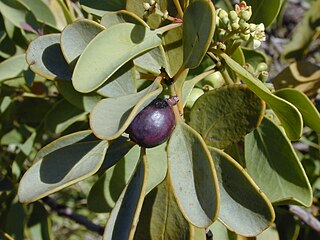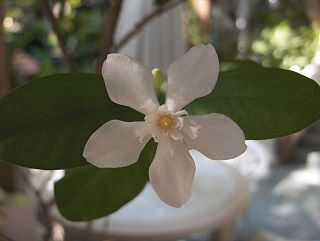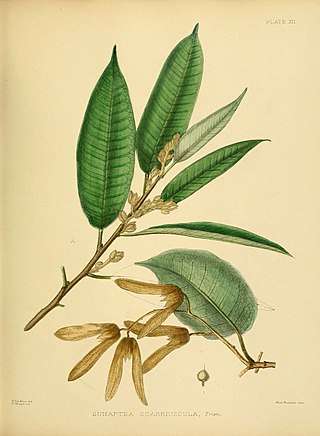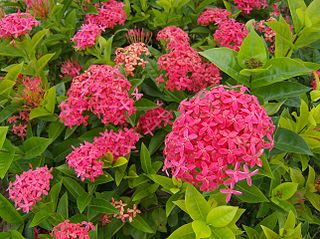
The Cucurbitaceae, also called cucurbits or the gourd family, are a plant family consisting of about 965 species in around 95 genera. Those most important to humans are the following:

The Santalaceae, sandalwoods, are a widely distributed family of flowering plants which, like other members of Santalales, are partially parasitic on other plants. Its flowers are bisexual or, by abortion, unisexual. Modern treatments of the Santalaceae include the family Viscaceae (mistletoes), previously considered distinct.

Melastomataceae is a family of dicotyledonous flowering plants found mostly in the tropics comprising c. 175 genera and c. 5115 known species. Melastomes are annual or perennial herbs, shrubs, or small trees.

The Portulacaceae are a family of flowering plants, comprising 115 species in a single genus Portulaca. Formerly some 20 genera with about 500 species, were placed there, but it is now restricted to encompass only one genus, the other genera being placed elsewhere. The family has been recognised by most taxonomists, and is also known as the purslane family. It has a cosmopolitan distribution, with the highest diversity in semiarid regions of the Southern Hemisphere in Africa, Australia, and South America, but with a few species also extending north into Arctic regions. The family is very similar to the Caryophyllaceae, differing in the calyx, which has only two sepals.

Podostemaceae, a family in the order Malpighiales, comprise about 50 genera and c. 300 species of more or less thalloid aquatic herbs.

Litsea is a genus of evergreen or deciduous trees or shrubs belonging to the laurel family, Lauraceae. The genus includes a large number of accepted species in tropical and subtropical areas of North America and Asia.

Wrightia is a genus of flowering plants in the family Apocynaceae, first described as a genus in 1810. It native to tropical Africa, China, the Indian Subcontinent, Southeast Asia, Papuasia, and Australia. The species are all small trees or shrubs.

Anaphalis is a genus of herbaceous and woody flowering plants within the family Asteraceae, whose members are commonly known by the name pearl or pearly everlasting. There are around 110 species with the vast majority being native to central and southern Asia. There is one species native to North America that is fairly well known and popular in cultivation, namely the western pearly everlasting.

Zeuxine, commonly known as verdant jewel orchids, is a genus of about eighty species of orchids in the tribe Cranichideae. They are native to parts of tropical Africa, Asia, Southeast Asia, New Guinea, Australia and some Pacific Islands. They have relatively narrow, dark green leaves and small, dull-coloured resupinate flowers with the dorsal sepal and petals overlapping to form a hood over the column. The labellum has a pouched base and its tip has two lobes.

Olearia, most commonly known as daisy-bush, is a genus of flowering plants belonging to the family Asteraceae, the largest of the flowering plant families in the world. Olearia are found in Australia, New Guinea and New Zealand. The genus includes herbaceous plants, shrubs and small trees. The latter are unusual among the Asteraceae and are called tree daisies in New Zealand. All bear the familiar daisy-like composite flowerheads in white, pink, mauve or purple.

Cyanotis is a genus of mainly perennial plants in the family Commelinaceae, first described in 1825. It is native to Africa, southern Asia, and northern Australia.

Hopea is a genus of plants in the family Dipterocarpaceae. It contains some 113 species, distributed from Sri Lanka and southern India to the Andaman Islands, Myanmar, southern China, and southward throughout Malesia to New Guinea. They are mainly main and subcanopy trees of lowland rainforest, but some species can become also emergent trees, such as Hopea nutans.

Cotylelobium is a genus of plants in the family Dipterocarpaceae. The name Cotylelobium is derived from Greek and describes the receptacle. It contains five species distributed in Sri Lanka, Peninsular Thailand, Sumatra, Peninsular Malaysia and Borneo. All five species are listed on the IUCN redlist, as either vulnerable, endangered or critically endangered.

Coronidium is a genus of flowering plants in the family Asteraceae. The genus is endemic to Australia.
Hedyotis (starviolet) is a genus of flowering plants in the family Rubiaceae. Many species of this genus such as Hedyotis biflora, H. corymbosa and H. diffusa are well known medicinal plants. Hedyotis is native to tropical and subtropical Asia and to islands of the northwest Pacific. It comprises about 115 species. The type species for the genus is Hedyotis fruticosa.

Ixoroideae is a subfamily of flowering plants in the family Rubiaceae and contains about 4000 species in 27 tribes.

Glossocarya is a genus of flowering plants in the mint family, Lamiaceae, first described in 1843. It is native to Indochina, Sri Lanka, New Guinea, and Queensland.
- Glossocarya calcicolaDomin - Queensland
- Glossocarya coriaceaMunir - Queensland
- Glossocarya crenataH.R.Fletcher - Thailand
- Glossocarya hemiderma(F.Muell. ex Benth.) Benth. ex B.D.Jacks. - Queensland, New Guinea
- Glossocarya longifloraH.R.Fletcher - Thailand
- Glossocarya mollisWall. ex Griff - Myanmar, Thailand, Vietnam, Paluan Rabana in Malaysia
- Glossocarya premnoidesRidl. - Thailand, Perlis in Malaysia
- Glossocarya puberulaMoldenke - Cambodia
- Glossocarya scandens(L.f.) Trimen - Sri Lanka
- Glossocarya siamensisCraib - Thailand, Vietnam
Christisonia is a genus of flowering plants belonging to the family Orobanchaceae.
Cotylelobium lewisianum is a plant in the Dipterocarpaceae family. It is critically endangered.
















